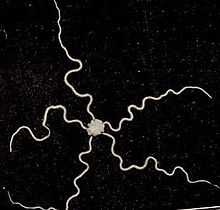Amphipholis
| Amphipholis | |
|---|---|
 | |
| Amphipholis squamata | |
| Scientific classification | |
| Kingdom: | Animalia |
| Phylum: | Echinodermata |
| Subphylum: | Eleutherozoa |
| Superclass: | Cryptosyringida |
| Class: | Ophiuroidea |
| Order: | Ophiurida |
| Suborder: | Gnathophiurina |
| Family: | Amphiuridae |
| Genus: | Amphipholis Thomas, 1966 |
| Species | |
|
see text. | |
Amphipholis is a large genus of brittle stars (Ophiuroidea) found in oceans worldwide from tropics to Arctic and Antarctic regions. Some species have been used to study echinoderm development (Amphipholis kochii[1]) and bioluminescence (the Dwarf brittle star, Amphipholis squamata[2][3]).
Systematics
Amphipholis is a large genus with potentially many cryptic species.[4] The high variability may be due to common parthenogenetic reproduction. The type species of the genus is Amphipholis januarii Ljungman, 1866(=Amphipholis gracillima (Stimpson, 1852)).
Species include:[5]
|
|
References
- ↑ Yamashita,M.,Embryonic Development of the Brittle-Star Amphipholis kochii in Laboratory Culture, Biol. Bull. 169: 131-142(Aug., 1985)
- ↑ P.Brehm, J.G. Morin. Localization and Characterization of Luminescent Cells in Ophiopsila californica and Amphipholis squamata (Echinodermata: Ophiuroidea) Biological Bulletin, Vol. 152, No. 1 (Feb., 1977)
- ↑ Dewael Y, Mallefet J., Luminescence in ophiuroids (Echinodermata) does not share a common nervous control in all species, J Exp Biol. 2002 Mar;205
- ↑ R.Sponer and M.Ray, Phylogeographic analysis of the brooding brittle star Amphipholis squamata (Echinodermata) along the coast of New Zealand reveals high cryptic genetic variation and cryptic dispersal potential.Evolution, Volume 56, Issue 10 (October 2002)
- ↑ MarineSpecies.org - Amphipholis Thomas, 1966